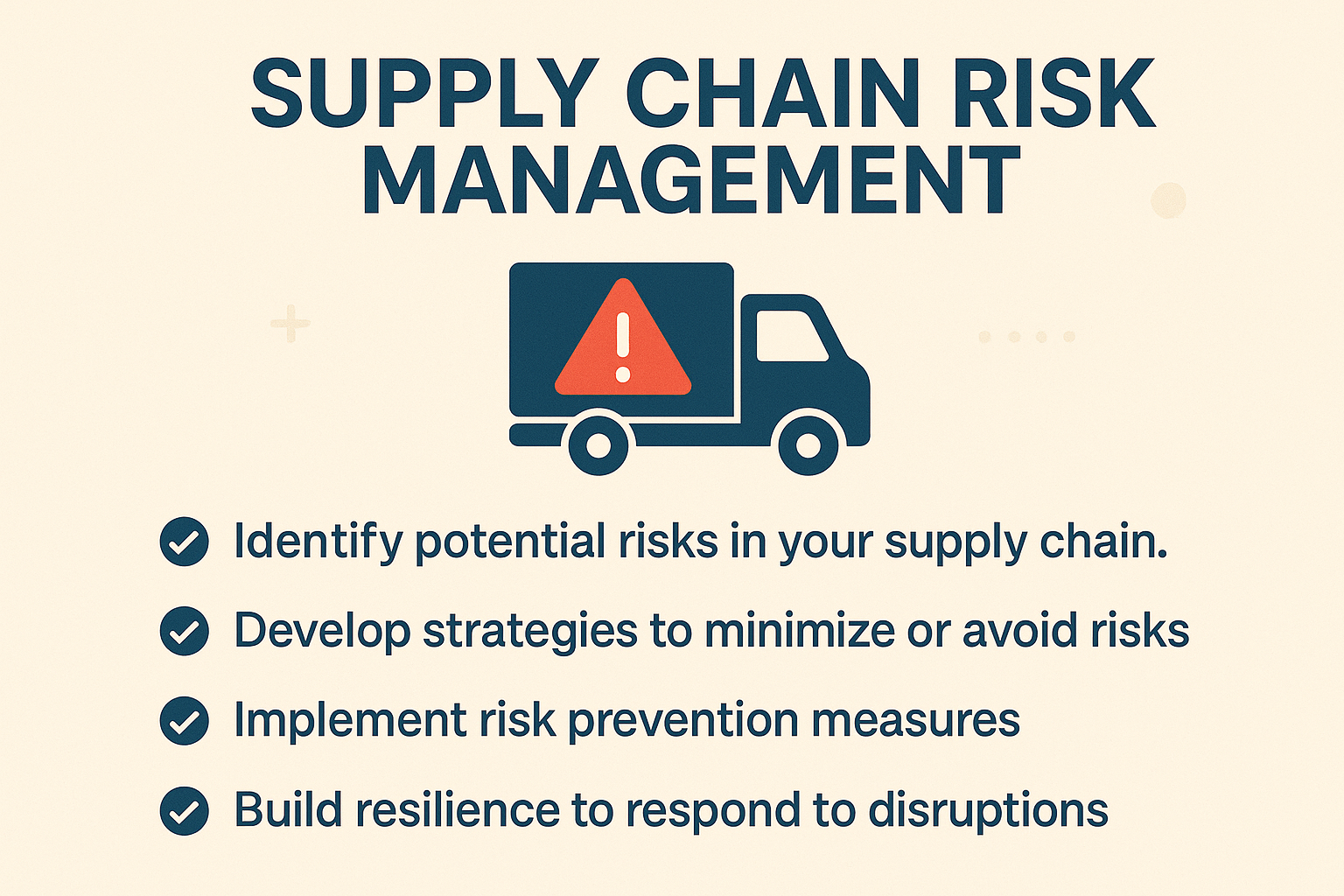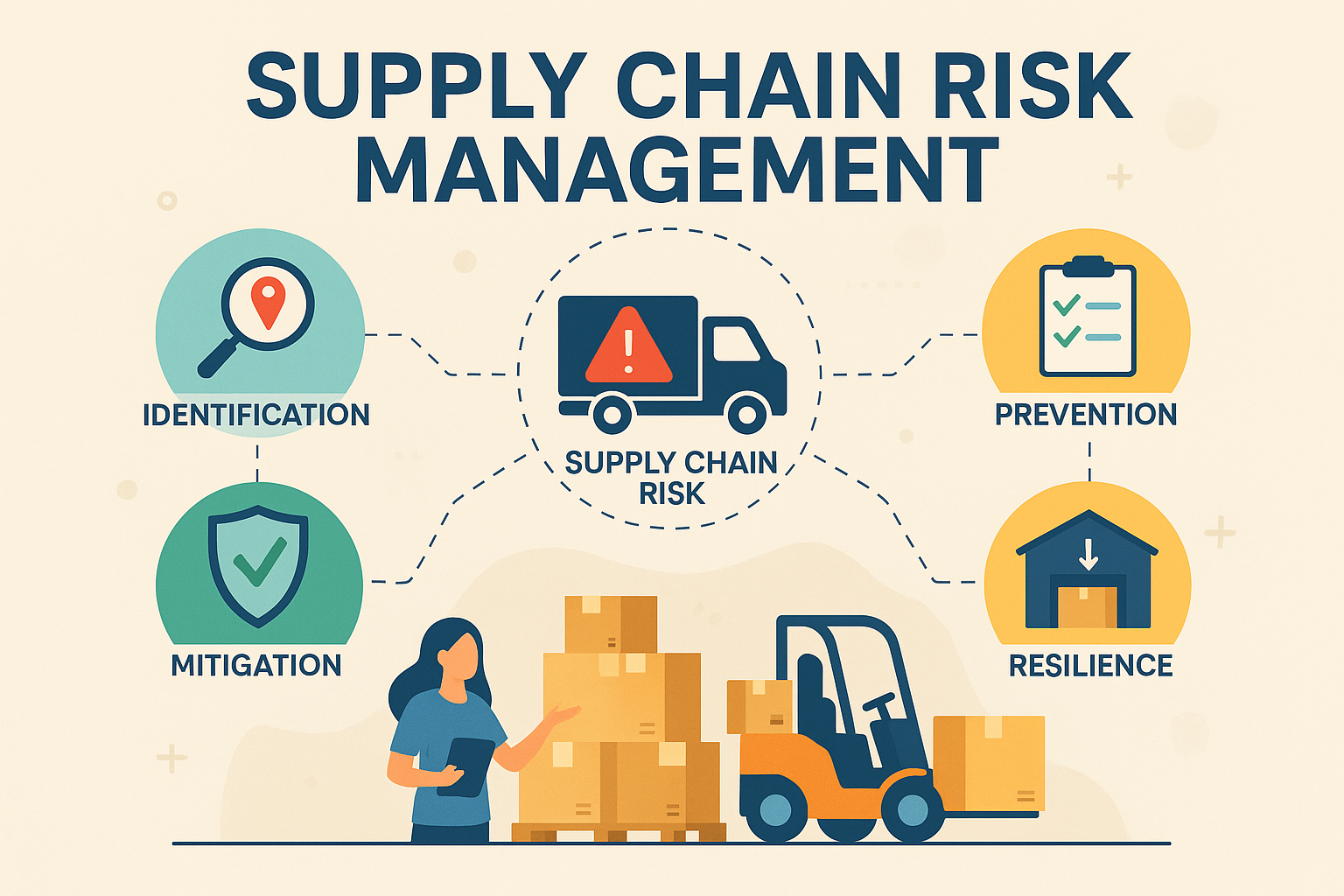Supply Chain Risk Management Plan: Best Practices for Implementations
Introduction
When you hear the words “Supply Chain Risk Management Plan,” you might picture something complex, a maze of logistics, disruptions, and contracts. But here’s the thing: understanding how to manage risks in your supply chain doesn’t have to be overwhelming. It’s really about having the right tools, strategies, and mindset to spot potential problems before they derail your business.
The actual definition of Supply Chain Risk Management Plan combined with its essential nature and strategic implementation strategies to maintain business continuity during unpredicted events will be our focus within this introduction.
What is Supply Chain Risk Management?
Supply chain risk management Plan requires businesses to detect possible threats in their logistics system followed by development of strategic responses. Different types of potential risks emerge from natural disasters through supplier bankruptcies and changes in foreign government policies without warning. When a setback occurs it should not disrupt your business operations severely.
You should take action in advance of problems occurring. Forecasting risks in advance enables you to establish preventive systems that protect your supply chain from breakdowns.
Why does this matter? A complex modern supply chain consisting of suppliers together with transportation factors and production elements and delivery mechanisms leaves many possibilities for things to take a wrong turn. A single errant factor in the supply chain will produce multiplying problems across the entire process. Every corner of the globe experienced supply chain interruptions due to COVID-19 which led to the global shortage of electronic devices and essential medical equipment. (Source: BBC News, 2025) According to BBC News (2025) Supply Chain Risk Management Plan has become even more essential due to its elevated importance.
The Key Concepts of Supply Chain Risk Management Plan
We need to understand the specific dangers they present to our business operations. Several risk types exist beyond natural disaster disruptions although those events create major disruptions. Additional to natural disasters you must identify various other kinds of risks in your supply chain operations.
-
Economic Risks: Content-related economic factors in supply chains embody costs of raw materials that shift together with foreign currency exchange rates and imposed international tariffs.
-
Operational Risks: Operations have multiple risks that include broken equipment and delayed manufacturing alongside staff strikes which disrupt the supply chain system.
-
Geopolitical Risks: Your sourcing approach becomes vulnerable to geopolitical problems that stem from unstable political environments and modifications of international trade regulations when you depend on foreign suppliers.
-
Cybersecurity Risks: As technology dominates supply chain networks cyber-attacks together with data breaches have become more frequent occurrences.
-
Supply Chain Visibility Risks: Supply Chain Visibility Risks Present Themselves Because Lack of Clarity Creates Delays Together with Mistakes that Yield Missed Opportunities for Problem Detection At Early Stages.
You can reduce and prevent supply chain risks through prepared strategies based on identified threats. Supply Chain Risk Management Plan development stands as the subsequent essential stage.
Best Practices for Developing a Supply Chain Risk Management Plan

Creating the risk management plan represents the most exciting point in the process. Your roadmap for managing unwanted situations should be developed during this phase. You need to follow specific best practices to establish an effective business plan which suits your company’s needs.
1. Start with Risk Identification
First off, you’ve got to know what you’re dealing with. Identifying risks is the cornerstone of any supply chain risk management Plan. This means looking at every link in your chain—starting with your suppliers and working your way down to your customers.
How do you identify risks?
-
Supplier Audits: Supplier Audits: Take a deep dive into your suppliers’ practices. Are they financially stable? The organization has established backup procedures. Does a global political landscape present any delivery-time obstacles for their operations?
-
Supply Chain Mapping: An analysis of your product supply chain needs to show every route that your materials follow during production until goods are ready for delivery. Camelot should evaluate systemic vulnerabilities to determine locations where supply chain disruptions would create the greatest problems.
-
Technology Risk Assessment: Review your technical framework to discover any security flaws within your cyber defense systems during your technology risk evaluation. Is your IT infrastructure up-to-date?
2. Assess the Risks (and Prioritize Them)
After recognizing possible risks you must proceed with their evaluation process for Supply Chain Risk Management Plan. What types of risks would inflict the greatest effect on your enterprise? What risks will most probably occur? Which of those issues call for instant priority resolution? The risk matrix represents an effective tool to assist you with this process.
The risk matrix represents a basic instrument for analyzing how likely risks will happen combined with their predicted consequences. The risk matrix analysis system enables you to determine what dangers should get rapid action.
3. Develop Mitigation Strategies
You must create solutions to address the risks for that you have identified in the previous step. Here are some common strategies to address risk for Supply Chain Risk Management Plan:
-
Diversify Your Suppliers: The use of a single critical part supplier creates a risk since you lack supplier diversity. Your business should distribute its procurement operations to minimize detrimental effects from single supplier failures.
-
Create a Contingency Plan: Establish a contingency strategy with back-up options because your main supplier network failure may occur. To prevent risks consider alternative suppliers and backup supplier routes and broaden your range of materials to use when necessary.
-
Insurance and Financial Protection: Insurance coverage and financial protection schemes should be considered since they protect against particular risks including natural disasters as well as transportation delays and equipment breakdowns.
-
Technology Solutions: Technology solutions require you to integrate tools of real-time monitoring for detecting issues as soon as they occur. AI and IoT technology provides businesses with immediate updates about their supply chain activities.
4. Implement and Test Your Plan
This is the most critical step—putting your Supply Chain Risk Management Plan into action. It’s no use having a plan if you don’t test it to make sure it works. Regular drills and simulations will help you see where the gaps are and fine-tune your strategies.
Technologies That Can Supercharge Your Supply Chain Risk Management Plan
Technology stands as the key relationship for Supply Chain Risk Management Plan within the present-day world. Innovation has produced several advanced tools along with systems which help both reduce risks and strengthen supply chain resilience.
1. Artificial Intelligence (AI) and Machine Learning
Artificial intelligence enables forecasting of possible disruptions during their initial stages. Machine learning tools let you study past records through data analysis to predict future supply issues or delivery problems according to recorded patterns. AI provides accurate forecasts of weather patterns and political instabilities across shipping routes as well as source nations where you do business.
2. Internet of Things (IoT)
You can achieve real-time supply chain observation through implementing IoT devices. The ability to track your products at every stage with absolute precision and automatic warnings regarding factory equipment breakdowns eases your Supply Chain Risk Management Plan.
3. Blockchain for Transparency
Cryptocurrency is a common application of Blockchain technology yet this technology works efficiently in supply chain visibility. The tracking system enables businesses to monitor product movement across the supply chain for ethical sourcing and compliance alongside anti-fraud protection.
4. Cybersecurity Solutions
Every organization needs cybersecurity included in their Supply Chain Risk Management Plan framework to combat escalating cyber threats. Protecting your data systems along with financial transactions requires you to put strong cybersecurity measures in place.
Common Mistakes to Avoid in Supply Chain Risk Management Plan
Organizations often lose track of essential details when managing risks as several frequent blunders cause significant issues for their programs. A review of mistakes to prevent appears next.
-
Underestimating Risks: Don’t downplay risks, especially when it comes to suppliers. Even if things seem fine now, they might change quickly.
-
Not Involving Key Stakeholders: The risk management plan should actively incorporate critical stakeholders who are involved in the decision process. Reach out for dialogue with both suppliers and logistics partners and customer base regarding future risk threats.
-
Failing to Review and Update Plans Regularly: Risk management plans require regular assessment and plan updating because they have an ongoing nature. The modifications that take place in the world environment also affect your potential risks. Regular reassessment and updates should be performed on your plan.
Conclusion: Building a Resilient Supply Chain for the Future
Business operations run successfully through proper supply chain risk management Plan /strategies even during unforeseen events in this complex and dynamic industry. Your business risk management needs to begin by recognizing each potential risk followed by priority sorting before creating applicable risk reduction measures. Your business operations will stay efficient by using technological tools.
Executing action before the occurrence remains the central factor for success. Creating an effective supply chain risk management plan assists both in business disruption protection and the development of a resilient supply chain strategy that can face upcoming challenges.

